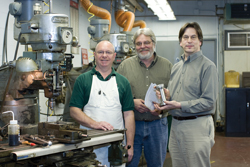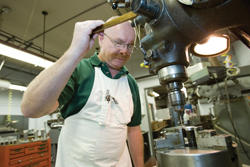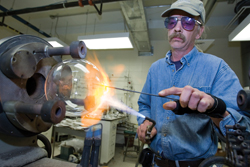Unsung heroes of science
|
On first sight, the Research and Instructional Support Facility (RISF) — tucked away in the bowels of Barton Hall — has the look of an industrial tool and die shop. There are mills, lathes, surface grinders and drill presses. But don’t let looks fool you. The facility, which has been enjoying a renaissance under College of Science and Technology Dean Hai-Lung Dai and Vice Dean George Palladino, has been quietly boosting Temple’s scientific research enterprise for the past few years. While the work of Temple’s scientific research faculty is often documented on the pages of prestigious, peer-reviewed journals, it is often the anonymous work of facility supervisor Ed Kaczanowicz, machinist Matt McCormick, electronics technician Richard Harris or glassblower Dave Plasket that plays a major role behind the scenes. |
 Photos by Joseph V. Labolito/Temple University
Research and Instructional Support Facility supervisor Ed Kaczanowicz (center) with machinist/welder Matt McCormick and Electronics Technician Richard Harris. |
|
The facility works with faculty and their graduate students or postdocs to modify existing equipment, or design and fabricate new equipment, to be used in funded research projects. “There is a lot of expensive equipment around the College of Science and Technology that isn’t exactly what the researcher sometimes needs,” said Kaczanowicz, who has been at Temple for more than 30 years. “There might be new developments in the science or in the hardware, and what we can do is make changes to that apparatus that will still allow it be used by that researcher for his or her intended purpose.” One example is a large stainless steel six-way cross that will be inserted into a vacuum chamber as part of a project being done by Physics Professor Marjatta Lyyra. According to her research proposal, Lyyra is attempting to produce a “cold molecular beam by expanding the vapor of the two constituent elements through a small orifice into a vacuum chamber. The metal vapor will be created in a hot oven and will be mixed with Argon carrier gas. Once the molecular beam is created and is sufficiently cold, it will enter a homogeneous electric field created between two flat electrodes.” “The whole assembly we made for Dr. Lyyra includes the oven, heaters, nozzle, insulation, gas supply, aiming and positioning parts of the oven,” said Kaczanowicz. “The ‘cold’ expanded beam created can now be accurately positioned with her lasers for study purposes.” The process usually starts with Kaczanowicz, who works with the principal investigator or graduate student to establish what the needs are and then begin to develop a design and a good set of drawings or schematics. |
|
 Machinist/welder Matt McCormick
|
“Once we have a good set of drawings, we get them approved by the person making the request, and then Matt, who joined the staff last fall, will work from those drawings to fabricate the piece and Richard will do any electronics work that might be required,” he said. There are several advantages to having such an on-campus facility. One is cost, while another is the opportunity for the staff to work closely with researchers on these “one-of-a-kind” items throughout the entire process. |
|
RISF charges an hourly rate that is “very, very competitive,” said Kaczanowicz. “Outside shops could easily charge a researcher $65 or more per hour. Plus, these outside shops do not to like to do ‘one-of-a-kind’ jobs. “We know right from the beginning what we are going to be making is going to be unique,” he said. “A lot of times, we are not so clever in those early designs to know everything that is going to be needed when you get into the fabrication process. By having an in-house facility, we can stop the process and make the necessary changes as soon as we realize something is not going to work. “With an outside production shop, if your drawing or schematic has a mistake in it, they are going to build that piece of equipment with that mistake in it,” Kaczanowicz added. “Then you need to start all over again. That can be very expensive.” Chemistry Professor Dan Strongin has experienced that problem firsthand. “We have shelves in the lab that are full of things that we sent out to have made or modified and they don’t work and we’ll never be able to use them,” said Strongin. Working with one of Strongin’s doctoral students, Soujanya Singireddy, RISF recently modified a Teflon cap for a sampling vessel to allow for the insertion of a septum. The high pressure reaction vessel is being used in a research project that is part of a NASA-funded astrobiology center. “They made the new cap within a day,” he said. “This cap is slightly modified from what we had originally planned on — and that’s the real advantage to having somebody onsite.” |
|
|
Going outside Temple was an option for Physics Professor Zein-Eddine Meziani when he needed a complex Cherenkov Detector built for his work at Jefferson National Laboratory in Virginia. But Meziani takes pride in the fact that the work could be done by RISF and the detector was put into use. “To me, it was really important to show what Temple could do in contributing to the experiment that involved a number of collaborators,” said Meziani, who was part of a three-member faculty committee who wrote a report on the necessity of RISF at the university. |
 Glassblower Dave Plasket.
|
|
In addition to fabricating pieces, RISF can also do welding and soldering, as well as work with plastics, machining and welding it to make such things as plexiglass boxes, airtight boxes and see-through boxes. A resource meant to support instruction and research throughout Temple, the facility also offers diagnostic repair, design and fabrication of electronics equipment. “If someone needs a special piece of electronic equipment, a machine you may find in an electronics catalog is often way more than is actually needed,” said Kaczanowicz. “What Richard is able to do is determine what the basic circuit might be and then, for really no money at all, put something together in a way that matches exactly what the researcher really needs for laboratory use.” Designing and customizing a research apparatus that is not commonly available is a central piece of glassblower Plasket’s mission. “The researchers or their graduate students come to me and often they don’t know what they need,” said Plasket, who plies his trade on the second floor of Beury Hall. “I work with them to figure out what they are attempting to do and then I design something that they can use. And he does a fair amount of troubleshooting when a system he designs doesn’t work as intended. “The vacuum system I built for one of the chemistry faculty is collecting too much solvent,” said Plasket, who has been glassblowing for 30 years, 22 of them at Temple. “Now I have to go back and redesign it to correct that particular problem. It’s not a one-size-fits-all type of deal in research.” Plasket is philosophical about the important, yet often anonymous role he and his colleagues play in Temple’s research enterprise. “Thomas Edison invented the light bulb,” he said. “Who you never heard of was the glassblower or the person who sealed the metal into the glass. Edison had a whole team of glassblowers and all they did all day long was to make different light bulbs for him to test. Does anybody know who they were?” |
|